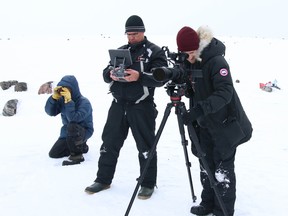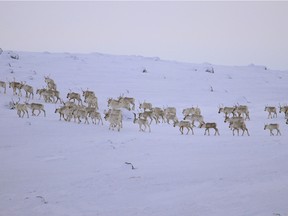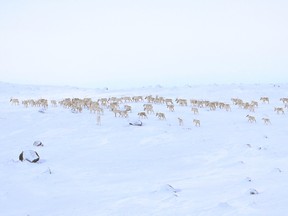An Ottawa-raised filmmaker examines this query within the just-released documentary HERD, that includes interviews with Inuit elders, youths, hunters and cooks.

Opinions and proposals are unbiased and merchandise are independently chosen. Postmedia might earn an affiliate fee from purchases made via hyperlinks on this web page.
Article content material
Inez Shiwak can succinctly distill what the caribou meant to her when she was rising up in Nunatsiavut, the autonomous space claimed by the Inuit in northern Labrador.
Commercial 2
Article content material
“All the things,” says Shiwak. “It’s connecting to household, buddies and the setting the place I dwell.”
The 45-year-old remembers how caribou and caribou-hunting had been integral to household life and her neighborhood’s tradition. She remembers with the ability to kill her first caribou. She remembers listening to her father inform tales of caribou hunts when he was younger. She remembers seeing her prolonged household after they would go caribou looking.
Three a long time in the past, the migratory caribou herds that roamed Nunatsiavut numbered within the a whole bunch of hundreds, in response to estimates.
However for a wide range of causes, the caribou of Labrador went right into a steep decline. In 2013, Newfoundland and Labrador’s Division of Fisheries, Forestry and Agriculture stepped in to preserve the endangered animals by issuing a looking ban. The George River Caribou Herd in Labrador, the province famous, had drastically declined from better than 750,000 caribou within the early Nineties to simply 27,600 animals in 2012.
Commercial 3
Article content material
As well-motivated because the ban was, it wrenched away a pillar of life for the Inuit of Labrador similar to Shiwak.
That’s why she is so happy to have been a co-producer of the just-released documentary known as HERD, wherein interviews along with her individuals, from elders to youths to hunters to cooks, describe the connection between the caribou and the Inuit.
“I’m very proud to be part of this undertaking and to know that our voices might be heard and recorded for future generations,” says Shiwak, who can be Canada Publish’s postmaster in Rigolet, Nunatsiavut.
The movie’s director is David Borish, who relies in Toronto however is initially from Ottawa. The 28-year-old, who attended Glebe Collegiate, says the movie combines his longstanding pursuits in visible media and social and environmental points.
Commercial 4
Article content material
For Borish, who has an undergraduate diploma from the College of Guelph, the movie was an integral a part of his doctoral analysis at Memorial College’s faculty of arctic and subarctic research.
Along with producing a 45-minute movie for CBC Gem, the work by Borish, Shiwak and their colleagues generated an extended lower for Inuit communities and an abbreviated 15-minute model that Borish intends to undergo worldwide movie festivals.
In all, the staff behind the movie collected about 100 hours of footage, together with interviews, archival materials and scene-setting clips. Their work, which was funded by businesses such because the Social Sciences and Humanities Analysis Council, can be the premise for a number of already revealed analysis papers.
Commercial 5
Article content material
Borish got here on board the undertaking in 2016 and labored steadily on it, graduating together with his Ph.D final 12 months.
He first traveled to Labrador in 2018, filming strictly caribou throughout a comparatively quick go to.
“After we went as much as go movie, the most important group of caribou we might discover was about 200 caribou,” Borish remembers. “It was unimaginable for me to see and it was a fraction of what the congregation used to appear like.”

Through the winter of 2019, the majority of filming, interviews and information assortment was performed, Borish says.
It was essential to Borish that the undertaking carefully contain the Inuit. “The movie is a means of bringing Inuit and non-Inuit collectively,” he says. “I used to be directing it from a movie and analysis stance, nevertheless it was very a lot a community-led Inuit undertaking.”
Commercial 6
Article content material
The movie features a lot of its energy from the starkness of it imagery and the absence of narration. The documentary merely reveals individuals talking about totally different features of life each throughout and after the time of caribou looking. It was Shiwaks’s job to arrange interviews with the movie’s members and pose the questions.
The data shared by the interviewees accumulates and grows over the movie’s size. Ultimately, the movie paints an in depth and compelling image that delves into every thing from the revered place of caribou within the weight-reduction plan of the Inuit to the unhappiness that comes with now not looking caribou, whilst different features of conventional Inuit life are endangered.
The movie doesn’t examine the causes of the caribou decline. “It’s very difficult and never absolutely understood. It truly is a mixture of totally different interconnected points,” says Borish. He notes that caribou populations naturally undergo cycles, but additionally says elements starting from local weather change to the affect of human growth to ailments and parasites may very well be at play.
Commercial 7
Article content material

Shiwak hopes viewers will perceive upon seeing the movie simply how essential the caribou are to the Inuit of Labrador and the way a lot it harm when the precise to hunt caribou was taken away.
She provides: “My hope is that the caribou return to what they had been and that we are able to return to looking caribou. I hope the following technology will get to expertise the joy and freedom you are feeling when looking caribou.”
What: a documentary by and in regards to the Inuit of Labrador and the affect of caribou decline on them
Out there on: CBC Gem
Information: www.inuitvoicesherd.com
